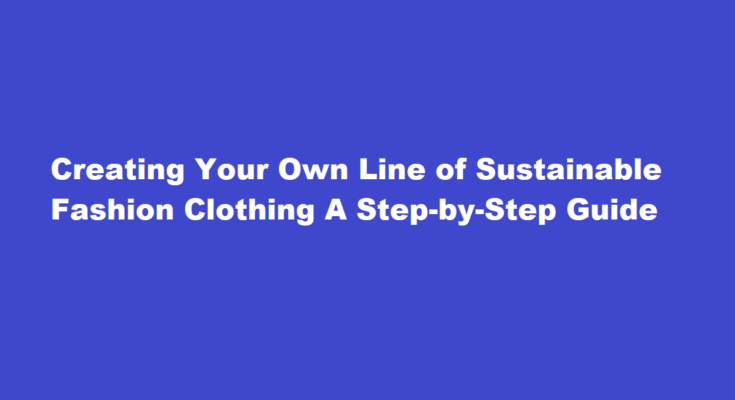Introduction
The fashion industry has a significant impact on the environment and society, with fast fashion contributing to pollution, exploitation of workers, and waste. As awareness about sustainability grows, more consumers are seeking eco-friendly clothing options. If you’re passionate about fashion and sustainability, starting your own line of sustainable fashion clothing can be a rewarding venture. In this article, we will guide you through the process of designing and creating your own line of eco-conscious clothing.
Research and Define Your Vision
Before diving into the design process, conduct thorough research on sustainable fashion practices, materials, and manufacturing processes. Understand the ethical and environmental implications of different materials, dyeing techniques, and production methods. Define your vision for the brand – your target audience, aesthetics, and values. Consider the unique selling points that will set your line apart in the sustainable fashion market.
Choose Sustainable Materials
Selecting eco-friendly materials is the cornerstone of sustainable fashion. Opt for organic, recycled, or upcycled fabrics that have a lower environmental impact compared to conventional materials. Organic cotton, hemp, bamboo, and Tencel are excellent choices. Recycled polyester and upcycled materials like vintage fabrics or reclaimed clothing can also be incorporated into your designs.
Design with Sustainability in Mind
Integrate sustainability into the core of your design process. Create versatile, timeless pieces that can be mixed and matched to promote a minimalist wardrobe approach. Consider the lifecycle of your garments, focusing on durability, repairability, and recyclability. Avoid trends that quickly go out of style, leading to unnecessary waste.
Seek Ethical and Transparent Production
Ensure that your manufacturing process aligns with ethical and fair labor practices. Collaborate with manufacturers that provide safe working conditions and fair wages to their employees. Transparently communicate the origins of your materials and the production process to build trust with your customers.
Embrace Slow Fashion
Adopt a slow fashion approach to counter the fast fashion culture. Instead of releasing numerous collections each year, focus on producing high-quality, limited-edition pieces. This approach helps reduce overproduction, waste, and the exploitation of resources.
Create a Strong Brand Identity
Develop a strong brand identity that reflects your values and resonates with your target audience. Your brand’s story and mission should be communicated through branding, packaging, and marketing materials. Be transparent about your sustainability efforts and progress to build a loyal customer base.
Prototype and Testing
Before moving into full-scale production, create prototypes of your designs to test their fit, comfort, and durability. Gather feedback from friends, family, or potential customers to refine your designs. Consider a pre-order system to gauge demand and prevent excess inventory.
Collaborate and Network
Collaborate with other sustainable fashion brands, NGOs, or influencers in the eco-conscious community. Networking can help you gain exposure, learn from others’ experiences, and find opportunities for growth and improvement.
Launch and Market Strategically
Plan a thoughtful launch for your sustainable fashion line. Utilize social media, eco-friendly influencers, and sustainable fashion events to promote your brand. Highlight the unique aspects of your clothing, such as the materials used, the artisans involved, and your environmental initiatives.
Customer Education and Engagement
Educate your customers about the importance of sustainable fashion and how their choices can positively impact the planet. Engage with your audience through storytelling, blog posts, or workshops, sharing your brand’s sustainability journey and encouraging mindful consumption.
FREQUENTLY ASKED QUESTIONS
How do you promote a sustainable fashion brand?
When it comes to sustainable fashion, buying and selling second-hand clothes are great options as well. Influencers promote this by selling their own clothes and showing followers how quickly they can do it. They often sell items on multiple sites, like eBay, Facebook, and Instagram, on their personal blogs, etc.
Do people want sustainable clothing?
Approximately 65% of fashion consumers care about the environment, but only some regularly prioritize sustainability in their shopping. We measured consumers’ stated willingness to lower their impact across a wide set of sustainable actions and compared that to their actual behavior.
Conclusion
Creating your own line of sustainable fashion clothing is a fulfilling endeavor that contributes to positive change in the fashion industry. By prioritizing eco-friendly materials, ethical production, and a slow fashion approach, you can offer consumers stylish clothing choices that align with their values. Remember that sustainability is an ongoing journey, and continuously seek ways to improve your practices and inspire others to join the movement towards a more sustainable fashion future.
Read Also : Unlocking Human Behavior A Guide to Conducting Psychological Experiments



